By Casey Clark Kelley
High mileage days require planning before you even hit the pavement, especially if you want to complete a successful training day. Mapping out your route, setting your expected pace, and even day-before carb-loading are all part of the distance runner’s life. One thing we often take for granted is our safety. There are many factors that can turn dangerous if you aren’t prepared. Make safety part of your long distance plan to stay ahead of potential hazards.
Know your routes. Mapping out your run is important so you know what to expect, but it is important to be present even if you are on a familiar path. We all have our own ways of passing time on the miles. If powering along to your favorite playlist is what keeps you going, you know how easy it is to lose grasp of what’s going on around you. With music as a distraction you lose the protective sense of hearing. If a preoccupied driver comes up behind you, sound is often your only warning sign to get out of the way. If you can’t imagine running without Beyoncé, then use designated running trails that will keep you away from traffic. Even if you’re a meditative runner who needs nothing more than wandering thoughts to keep you company on a run, you still need to do some mental reminders to check in from time to time.
Fuel Up. Maybe you have this down to a science by now or maybe you are just figuring out how your body is handling the miles, either way make a hydration and nutrition plan. Drink water before you leave and sip every 15 to 20 minutes throughout your run, the amount you need varies individually, but always make sure you have plenty. A water backpack or belt may feel cumbersome to your agility, but without it you could end up dehydrated and too zapped of energy to complete your intended distance.
If you’re going over 10 miles you should have an energy source on hand. The key is to use it before you need it. High-octane fuel sources like sports nutrition gels and chews are designed to quickly give you carbohydrates and electrolytes which will help prevent muscle cramps and dehydration. All-natural versions are available which can be gentler on your stomach, made with recognizable ingredients like pureed strawberries and honey. These options are very lightweight and easy to store while you run, but if you prefer a banana to keep you going, that will do the trick too.
Stay cell connected. Some runners don’t run without their phone, but if you’re like me bringing it along means no escape from the demands of daily life, as well as just another thing to carry. If you prefer to go disconnected, a sprained ankle, sudden digestion issues, or a sketchy looking truck will leave you cursing yourself for your carelessness. The SportPort Apex Compression Bra is what changed my mind about the hassle of running with my phone. It has a built-in cell phone pocket with 4-way stabilization so the phone doesn’t bounce around. The bra also has patented technology which creates a barrier between your body and the potentially harmless EMF radiation of your phone. Muting the sound and storing it away, you can still stay connected without being distracted, while having an easy back-up plan if things go south.
Safety in numbers. Distance running can be a very solitary sport and a lot of us like it that way, but there’s no harm in switching things up. Running with a buddy can actually help the miles pass quickly as you cover everything from marathon tips to local gossip to the funny thing your dog did yesterday. No long distance friends? Ask the local running store how you join one of their groups.
Extra supplies. If you are a gal who regularly runs alone, you’ve probably brought out the protective nature of your loved ones. You may even have a can or two of runner’s mace that was gifted to you. It’s easy to think this isn’t something you need, but it doesn’t mean you shouldn’t have it just in case. A woman alone is an easy target for lurking predators and the “it won’t happen to me” mentality won’t protect you. Have it on hand and know how to use it.
Long distance running requires conscientious planning and commitment. Prepping can be a fun part of the process, so don’t let safety concerns hold you back, just be prepared and enjoy the miles as they go.
Casey Clark Kelley is a writer, certified lifestyle coach and fitness instructor. She enjoys staying active with long distance running, cycling and cross-country skiing as New England weather allows. Info@caseyclarkkelley.com







